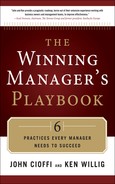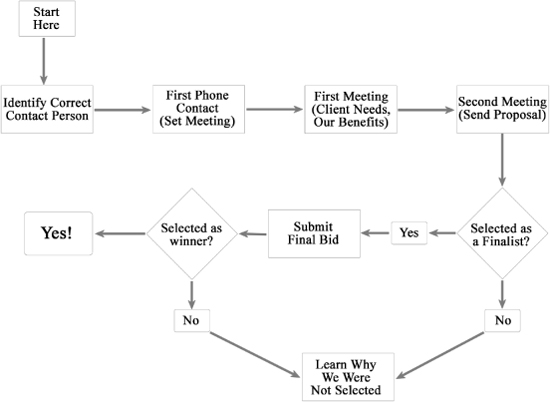The sales process
These two activities, lead generation and closing, are the heart of the sales process. The leads and strong leads categories focus the company on generating leads, listening to the customer to understand needs, and qualifying the prospective customer. The highly likely category focuses the company on activities needed to close the sale, such as convincing the customer that you can provide compelling benefits.
The sales process for your company should address both these activities in detail. In fact, many firms have thoughtful ongoing sales training programs for both these activities.
In order to manage the overall sales process, you should track your prospective customers by each of the categories in the sales funnel. At a minimum, you should monitor the number of customers in each category, the sales dollars for each category (if available), and the probability of securing the sale for each of the prospective customers (especially important for the highly likely category). You also should create specific plans to move potential customers along the funnel to become actual customers.
The sales process for your firm should be a structured series of activities undertaken to maximize sales to your target customers. It should be based on the best sales practices for your firm, and consequently the process itself will be virtually unique to your firm. For example, a telemarketing firm will have an entirely different sales process than an engineering firm.
There are, however, some generic activities that can be applied to your firm. Because the sales process should be a structured series of activities, the first step in creating the process is to describe these major activities. Then, you should provide exacting detail and training for each step so that everyone uses the firm’s best practices.
Your firm’s selling activities can perhaps best be represented as a flow chart, an example of which is shown on page 139. Starting with the initial contact with a potential customer, the firm will identify each step in the selling process and then provide details on how each step should be conducted.
Let’s assume that you have generated a lead (the name of a potential customer). You might view the first step in your sales process as an initial contact with this person.
Rather than simply call the person and “wing it,” however, you decide to plan this call carefully in order to make your best introduction and first impression. In fact, you’d want everyone in the firm to use this same approach in other first calls with your prospects. We’ve provided an example for this first phone contact in Appendix D.
The previous diagram and the information on a first phone contact are only examples, and they most likely will not be directly applicable to your firm. You likely will need to modify these examples to your own situation, and through time you should continually search for and use the best practices for each step.
To make the process complete, of course, requires that you use this approach for every step of the process. And this goes way beyond mere mechanics. You should constantly search for effective ways to improve each step of the process.
For example, we’ve mentioned using your “best introduction.” The idea here is that through time you have tried different introductions, paid close attention to customers’ reactions, and created the best introduction you know. You’ve chosen your words and phrases with care in order to serve your target customers in a highly effective way.
This approach never ends—you continually refine each step of the sales process when you learn something more effective. And that is a real plus of using a system—everyone knows and uses best practices and tries to improve upon them continually, so everyone on the team can benefit from everyone’s experience and expertise.
In order to improve upon current practices, people must be allowed to try new things. In effect, you allow your folks to experiment with the steps in the sales process, adopting ideas that work better than the old ones.
One way to determine the effectiveness of your experiments is to measure results frequently. The objective, of course, is to improve the sales funnel, to generate more leads in the beginning, and to bring more of those leads to final sale.
Furthermore, you can measure your results at each stage of the sales funnel. If the company is declining in its ability to bring strong leads to highly likely, you probably will need to modify the procedures being used by your salespeople in those steps.
In essence, the sales process is a trial-and-error development process. But the process is based upon the collective best practices of everyone in the group. And everyone in the group uses the best ideas available.

